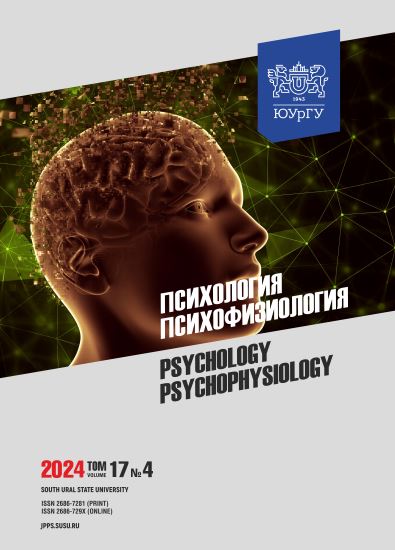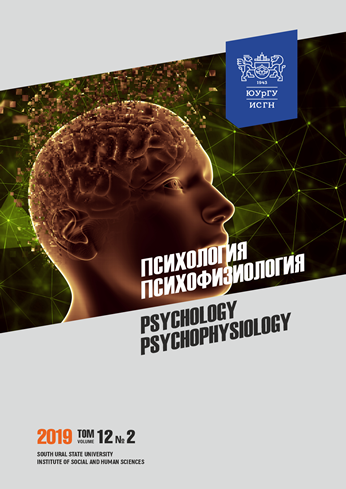The psychological structure of temperament in students with different levels of volitional self-regulation
Abstract
Introduction. This study examines the predictors and determinants of professional formation, with a focus on the qualitative formation of professional competencies. Aim: this research aims to identify how gender affects the psychological structure of temperament in students with different levels of volitional self-regulation. Materials and methods. 417 senior students of both sexes (average age 21.7 ± 1.5 years) were surveyed, focusing on their volitional self-regulation and the psychological structure of temperament. Participants were grouped based on their levels of volitional self-regulation: 243 female students (low – 61, moderate – 76, high – 106); 174 male students (low – 28, moderate – 47, high – 99). Mathematical and statistical analyses were carried out using nonparametric statistical methods. Results. Female students with high volitional regulation showed more flexible behavior patterns (indeterminate type on the “Rigidity-Plasticity” scale). Emotional excitability was more prevalent among female students regardless of their levels of volitional self-regulation. Female students with high volitional self-regulation had lower reaction rates than male students of the same group. Male students with low volitional self-regulation were more likely to be introverted than female students of the same group. Male students with high volitional self-regulation were less likely to show emotional excitability and high reaction rates compared to female students. Conclusion. Understanding the psychological structure of temperament in students with different levels of volitional self-regulation can inform more effective teaching and professional strategies.
Downloads
References
2. Potapova M.V., Shibkova D.Z., Baiguzhin P.A. Current tasks and resources for improving the quality and competitiveness of the modern education system. Vestnik Yuzhno-Uralskogo gosudarstvennogo universiteta. Seriya: Obrazovanie. Pedagogicheskie nauki = Bulletin of the South Ural State University. Ser. Education. Educational Sciences. 2024;16(3):5–16. (in Russ.). DOI: 10.14529/ped240301
3. Merlin V.S. Ocherk integralnogo issledovaniya individualnosti [An essay on the integral study of individuality]. Moscow. Pedagogika Publ. 1986:256.
4. Vyatkin B.A., Dorfman L.Ya. Theory of integral individuality by V.S. Merlin: history and nowadays. The Education and Science Journal. 2017;19(2):145–160. DOI: 10.17853/1994-5639-2017-2-145-160.
5. Dorfman L.Ya. Development and enrichment of the theory of integral individuality. Gumanitarnye issledovaniya. Psikhologiya i pedagogika = Humanitarian Studies. Pedagogy and Psychology. 2024;19:69–81. (in Russ.). DOI: 10.24412/2712- 827Х-2024-19-69-81
6. Belykh T.V. Structure of integral individuality of students with different self-efficiency in learning activities. Gumanizatsiya obrazovaniya = Humanization of education. 2017;3:32–37. (in Russ.).
7. Rylskaya E.A., Moshkina L.D. Integral individuality of students: gender characteristics of the structure. Science for Education Today. 2020;10(3):45–64. (in Russ.). DOI: 10.15293/2658-6762.2003.03
8. Cherenkova S.L. Development of integral individuality in student age. Daidzhest sotsialnykh issledovanii = Digest of social studies. 2022;2(6):29–33. (in Russ.).
9. Morosanova V.I. Conscious self-regulation of voluntary human activity as a psychological resource for achieving goals. Teoreticheskaya i eksperimentalnaya psikhologiya = Theoretical and experimental psychology. 2014;7(4):62–78. (in Russ.).
10. Psikhologiya individualnykh razlichii [The psychology of individual differences]. Ed. by Yu.B. Gippenreiter, V.Ya. Romanov. Moscow. MGU Publ. 1982:140. (in Russ.).
11. Makunina O.A. Psychophysiological status comprehensive assessment of students-sportsmen during combined activities. Sovremennye problemy nauki i obrazovaniya = Modern problems of science and education. 2015;2-3:254. (in Russ.).
12. Kirsanov V.M. Psychophysiological and Individual Typological Features of Full Time University Students of the Ural Region. Psikhologiya. Psikhofiziologiya = Psychology. Psychophysiology. 2020;13(2):86–95. (in Russ.). DOI: 10.14529/jpps200208
13. Ilin E.P. Differentsialnaya psikhofiziologiya [Differential psychophysiology]. Saint Petersburg. Piter Publ., 2001:464. (in Russ.).
References on translit
-Copyright (c) 2024 Psychology. Psychophysiology

This work is licensed under a Creative Commons Attribution-NonCommercial-NoDerivatives 4.0 International License.



